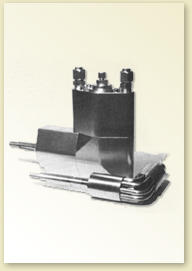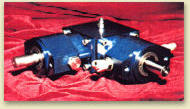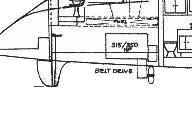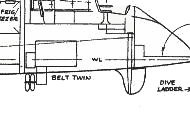
|
There are quite literally thousands of ideas and designs for propelling a vessel thru the water under power. So many in fact that we couldn't even reference a goodly portion of them here, let alone discuss them. We will therefore limit ourselves to two particular ideas which have intrigued me, and that I believe have significant potential for development aboard multihull cruising vessels (as well as many others). Both of these concepts involve the use of propellers. Screw propellers are one of the oldest forms of propulsion, relatively simple, and still one of the most efficient. An excellent reference work on this subject would be Dave Gerr's book, " The Propeller Handbook". And with a solid grip on the water, the propeller system excels at maintaining station while maneuvering in close quarters. The efficiency of the screw propeller is improved, if we can increase our propeller diameter and turn it more slowly. There are many obstacles to realizing this ideal form, but the two primary ones involve the manner in which the power is transmitted to the prop;..ie, the drive train. First most marine gear boxes are available only in certain singular reduction ratios, and these ratios are based on current drive system parameters, and second, the prop diameter is most often dictated by the limitations imposed by the drive shaft's inclinations/lengths, V-configurations, strut supports, hull shape etc. Very often the designer must place the engine and/or the prop in a less than ideal location, and make use of a less than ideal prop size. The two drive systems I present here overcome many of these obstacles.
While working on a new bow thruster design, a Hungarian gentleman has developed and built several entirely new and unique gearless, twin-rotor, angular-piston, hydraulic motors. This patented mechanism employs two rotors which are interconnected by angular pistons that are all contained and bearing mounted in a common housing. The linear displacement of the pistons in one of the rotors is directly converted into the rotational motion of the other rotor, interactively. The geometrical and mechanical relationship between the two interconnected rotors provides optimum conditions for direct conversion of linear displacement of the pistons into rotational displacement of the rotors. Barring frictional losses, the conversion is 100% efficient. None of the commercially available axial piston motors have such direct and efficient means for converting linear displacement into rotational motion. And maybe more importantly, the design is greatly simplified by the elimination of the traditional angular swash plates, sliding shoes, and related components. There are many fewer moving parts in this motor, which should significantly increase their reliability while decreasing the maintenance and manufacturing cost of these units. Simultaneous linear and rotational motion of the pistons within the rotor bores results in even wear, increasing the life of the motors.
|
|||||||
|
|||||||
|
The motors are bi-directional, and the direction of the rotation can be selected externally by valves, or internally by interchangeable valve plates. The motors have automatic hydraulic pressure and propeller thrust compensation. The replacement of the mechanical transmission by hydraulic components provides a stepless speed control from stand still to full speed, as well as instant reversal, reportedly assuring the availability of full power at any moment. Having no mechanical connections between the engine and the propeller drive units, the marine designer has complete freedom in the positioning of single or multiple propeller drives and the engine units themselves. A number of bow thruster units are in service. The potential applications for these motors go far beyond the marine field. Their simplicity and light weight make them prime candidates for the aircraft industry,etc.,etc. Venture capital is being sought.
I am particularly interested in the adaptation of the new generation, ultra-high strength, power transmission belts to the marine drive situation. Their aramid fiber tensile cords are imparting extraordinary strength and load carrying power. They are tough....you can hardly cut it. They have a higher modulus than steel and virtually zero elongation. The fatigue life is exceptional and its high impact strength withstands shock and surge loading. The fibers are also thermally stable thus remaining operational under extreme temperatures, and they are chemically inert to resist oils, chemicals, pollutants, corrosion, etc. Their toothed design results in a positive slip-proof engagement. Unlike flat and V-belts, they do not rely on friction for their pulling power, and thus tension and loads to the bearings are lower.
We see these belts being used in an ever increasing number of applications, and particularly in many heavy industrial equipment drives. Load capabilities range from fractional to hundreds of horsepower. Just two visual examples...replacing Harley Davidson motorcycle chains and driving superchargers on hi-powered dragsters. So why no marine applications? Actually there are quite a number of individual small projects that have been done, but there is no central source of data or records related to these examples, and no attempt to do a general concept that might have a greater adaptability throughout the marine field. Within this site we hope to gather the past records of both failed and successful marine belt-drive projects and continue to evaluate the potentials. I presently have some info on several small projects, and I have done a patent search on similar drives at the US Patent office here in Washington, DC. Other than direct straight-shaft drive of propellers, most marine drives today involve some sort of 90 degree arrangement, ie.sail drives, stern outdrives, outboards, etc. The 90 degree gear set (and there are usually two sets) is the potential weak link in the system. All the power is being transferred over a very physical small contact area between two bevel gears. This contact patch can be nothing more than a thin line on the opposing two teeth! Special hardened gears and maintaining close-fit tolerances permit the horsepowers of today. But when it comes to diesel engines, the situation gets worst. The diesel is by its nature a much more torque'y beast. Gears to handle an even modest horsepower diesel are extra hard pressed. Teeth can break or get worn so quickly as to loose all tolerance. The belt-drive configuration could eliminate both sets of 90 degree gears. And if desired the drive system might be rotatable about the shaft opposite the prop shaft end (the prop could be rotated out of the water when not in use). I've included just a couple of quick, undetailed sketches at this time......
|
|||||||
|
|||||||
|
To Be Continued... PS. We want to invite audience participation. If you have any information on a belt drive installation, we would like to receive it for inclusion in our data file. We also invite anyone to submit their ideas, design (in whole or part), etc. for possible inclusion in the final product. We can not offer you any guarantees that you will receive any monetary considerations or patentable considerations for your submissions. We may incorporate an idea of yours into our final product, but you may not have any patentable redress. We certainly will attempt to give all reference acknowledgments that we can. An interesting Web site reference: www.virtualpet.com, Research Tools & Papers, "U.S. Commercialization of Innovative, Propeller Driven, Recreational Marine Drive Designs". |
|||||||






